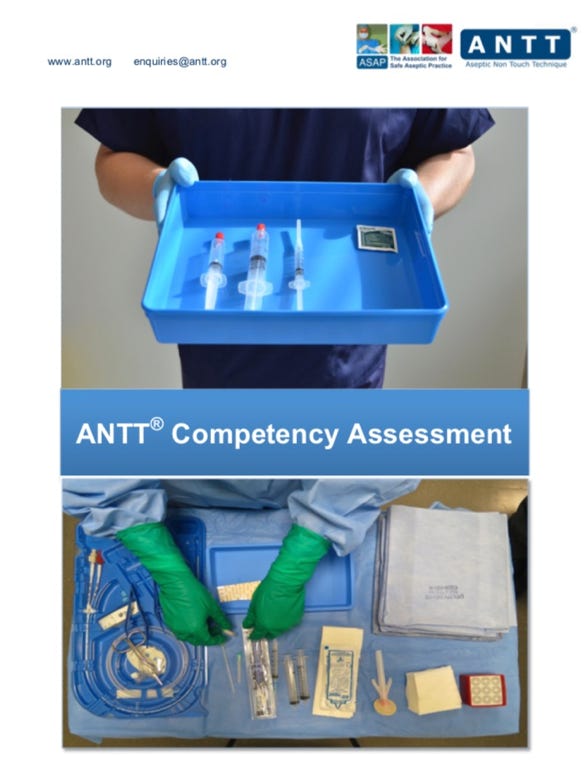


ANTT® Competency Assessment
Competency is critical to patient safety
Just like for any other important clinical competency, it is critical to patient safety that healthcare workers involved in any type of invasive clinical practice or maintenance of invasive medical devices are assessed periodically for ANTT competency.
What is ANTT Competency?
ANTT Competency is when a healthcare worker can articulate and demonstrate the ANTT Clinical Practice Framework in clinical practice.
Minimum knowledge and clinical practice requirements:
The healthcare worker can articulate and/or practice …
• Why asepsis is the aim of ANTT, and why ‘sterile’ or ‘clean’ can’t be
• The process used to achieve asepsis – Key-Part and Key-Site Protection
• Know what Key-Parts and Key-Sites are and can demonstrate their protection
at all times
• Understand and articulate the ‘Key-Part / Key-Site Rule’
• The two ANTT approaches: Standard-ANTT & Surgical-ANTT
• The ANTT Risk Assessment - to determine the ANTT approach
• The three types of aseptic fields used in ANTT and demonstrate their
correct utilisation
How is ANTT Competency Assessed?
In ANTT, Competency is typically assessed (and advised) with both theory and practice assessment. Our official ANTT Competency Assessment Tool (CAT) is ideal for this and incorporates some questioning of ANTT principles and terms during the practical assessment. (Free on request). The CAT tool can be applied to any clinical procedure
The practice language of ANTT is important
Mostly, this is because it helps demonstrates understanding of the principles and process of ANTT. Also, when healthcare workers all speak the same practice language they can have more meaningful practice discussions and patient safety is naturally enhanced.
Individual responsibility
Healthcare workers are expected to practice at all times within the scope of their knowledge, experience and clinical skills. In most countries they need to be able to demonstrate this through education, training and assessment
Organisational responsibilities
Healthcare organisations have a responsibility to ensure staff are educated and trained effectively to undertake any given procedure. ANTT competency should be unequivocally defined and described in organisational policy and related procedure documents. As well as implementing ANTT effectively, organisations need to maintain it effectively too. (Just like any other important patient safety related competency).
More countries now mandate requirements for aseptic technique and monitor them through regulations and regulators. For example, in England and Wales, it is a legal requirement for all healthcare providers to have a single standard aseptic technique, that is demonstrable by education, training and assessment, and practice standards monitored (click here to see publication). Increasingly, countries are increasingly mandating ANTT as their single standardised approach to clinical practice (see here). The-ASAP actively supports organisations and governments to implement and maintain best practice ANTT.

Validation
A validation paper is available freely on request. enquiries@antt.org
Click to play…
This short ANTT Quick Impact Video is easily accessible by mobile and tablet etc using this link (https://youtu.be/YvJ_pTnRVzE) and is an instant reminder of the essential knowledge required to pass ANTT Competency.

What is the typical process of ANTT Competency?
Who can practice, educate and competency assess ANTT?
Of course, this is for organisations to decide. We recommend a tiered approach:
Level 1: ANTT® Practitioner
This is the minimum assessed competency standard for individual clinical staff; it is designed to provide a broad introduction to the theory and practice of the ANTT-Approach and requires that individuals have received ANTT education and training and have been competency assessed by a Level 2 or 3 ANTT Trainer.
Level 2: ANTT® Trainer
In addition to the requirements of Level 1, the individual has attended an ANTT® Competency Assessor Training Day led by an experienced Level 2 or 3 ANTT® Trainer and has been assessed as being competent to assess other staff in ANTT®
Level 3: ANTT® Advanced
As well as being compliant with the requirements of Level 1 & 2 above, this individual is likely to act as an ANTT Lead for the organisation.